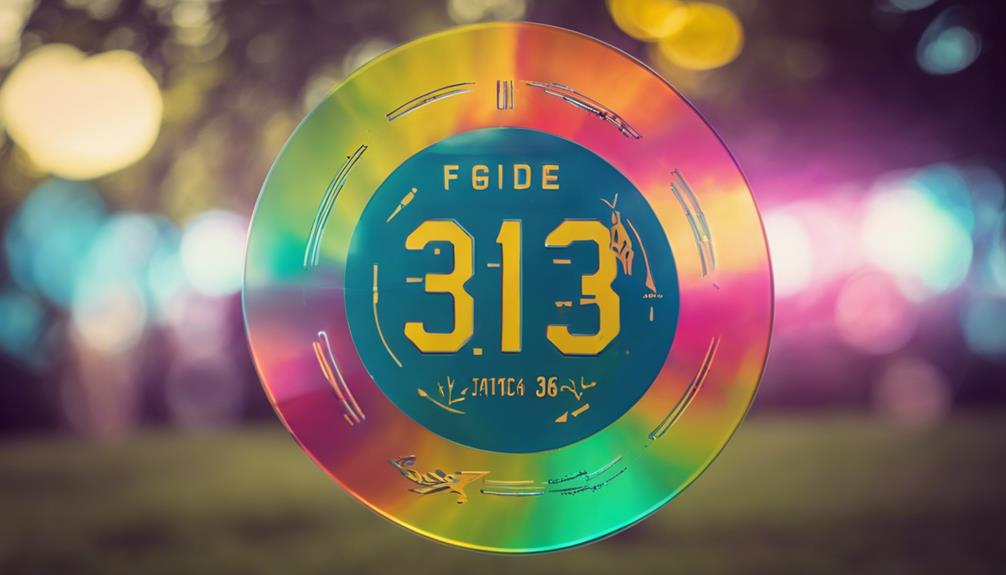Disc golf discs come with **flight numbers** that give clues about how they fly. The **speed rating** (1-14) tells how fast a disc travels. The **glide rating** (1-7) shows how well it stays in the air. The **turn rating** (-5 to +1) hints at the disc’s first flight direction. Finally, the **fade rating** tells if it hooks left at the end. These numbers help players pick discs that fit their style and the course. Knowing these flight numbers can really **boost your game** by helping you select the perfect discs for your skills and goals.
Key Takeaways
- Speed rating indicates disc's flying speed from 1 to 14 for matching throwing power.
- Glide rating reflects disc's air time potential, impacting distance and accuracy.
- Turn rating describes disc's initial flight path tendency, crucial for shaping shots.
- Fade rating signifies disc's leftward hook at flight end, aiding in predictability.
- Understanding flight numbers optimizes disc selection for desired flight characteristics.
Understanding Flight Number Basics
When delving into the world of disc golf, understanding the basics of flight numbers is essential for players aiming to enhance their game. Flight numbers encompass Speed, Glide, Turn, and Fade ratings, vital for selecting the right discs to match one's playing style and course conditions.
The Speed rating indicates a disc's best flying speed, from slow (1) to fast (14), influencing distance potential and wind resistance. The Glide rating reflects a disc's ability to maintain loft during flight, impacting distance and hang time, with values ranging from minimal (1) to maximum (7).
Turn rating describes a disc's initial flight path tendency, affecting shot shaping and maneuverability, ranging from overstable (+1) to understable (-5). Fade rating signifies the disc's leftward hook at the end of the flight, important for controlled finishes and wind resistance.
Understanding these flight numbers is crucial for players looking to maximize their performance on the disc golf course.
Decoding Disc Speed Rating

Moving from Flight Number Basics to Decoding Disc Speed Rating, understanding the significance of disc speed ratings is essential for players seeking to maximize their disc golf performance. The Speed Distance Driver utilizes the Flight Ratings System, with speeds ranging from 1 to 14.
Faster discs are ideal for windy conditions and upwind throws, as they cut through the air with ease. On the other hand, slower discs, with lower speed ratings, provide better control and can achieve greater distances when thrown downwind. High-speed discs, typically rated between 11 and 14, demand more power and aren't recommended for beginners.
Players must match the disc's speed rating with their throwing abilities and the desired flight path to ensure peak performance. Selecting the right disc speed is vital for maintaining control over the disc and achieving the desired flight characteristics based on individual skills and preferences.
Unveiling Glide Rating Secrets

Exploring the importance of glide ratings in disc golf reveals vital insights into a disc's ability to maintain loft during flight. Glide rating, ranging from 1 to 7, indicates how well a disc can stay in the air.
Discs with higher glide are favored by beginners and players aiming for maximum distance potential. These discs can stay airborne longer, aiding in achieving impressive distance throws.
In contrast, lower glide discs are advantageous in windy conditions, as they offer better accuracy. The glide rating directly impacts a disc's flight characteristics, affecting hang time and overall performance during throws.
Players looking to release powerful distance shots often opt for discs with higher glide ratings. Understanding the relationship between glide rating and a disc's ability to soar through the air can greatly enhance a player's game by improving both distance and accuracy on the course.
Demystifying Turn Rating Effects

Understanding the effects of a disc's turn rating is vital for disc golf players seeking to master different shot techniques and flight paths. Turn rating indicates a disc's tendency to bank to the right (for RHBH throws) or veer left during flight.
Discs with higher turn ratings, like -5, exhibit significant turn and are perfect for achieving turnover shots or rollers. On the other hand, lower turn ratings, closer to +1, offer more stability and resistance to turning over, enhancing accuracy in windy conditions.
Turn plays a critical role in shaping the flight path of a disc, with negative turn values aiding in flex shots and controlled turnovers. By understanding a disc's turn rating, players can anticipate and adjust for the natural flight characteristics of the disc during different shot scenarios.
This knowledge is key to achieving precise disc flight control and improving overall disc accuracy.
Exploring Fade Rating Significance

Fade ratings on disc golf discs play an essential role in determining the disc's behavior as it decelerates during flight. These ratings, typically ranging from 0 to 5, indicate how much a disc will hook left at the end of its flight.
Understanding the fade rating is vital for controlling fade, which in turn affects the predictability, accuracy, and distance potential of a throw. High fade discs with ratings up to 5 exhibit a strong leftward hook, while low fade discs with ratings closer to 0 result in a straighter finish as the disc slows down.
Impact of Plastics on Flight

Different plastics, such as Champion and Star, play a vital role in altering a disc's flight characteristics. Premium plastics like Champion and Star maintain the original flight attributes for a longer duration, whereas DX, XT, KC Pro, and R-Pro plastics exhibit quicker changes in flight behavior over time.
Plastic Types Influence
When selecting a disc for disc golf, the choice of plastic type greatly influences the flight characteristics of the disc. Premium plastics like Champion, Star, GStar, and Driver Pro maintain original flight characteristics for longer periods, providing consistency in performance.
In contrast, plastics such as DX, XT, KC Pro, and R-Pro are more prone to quicker changes in flight characteristics due to wear. Champion and Glow Champion plastics, for example, can reduce high-speed turn compared to Star and GStar plastics.
Understanding the impact of plastic types is essential for players to tailor their disc selection based on desired flight characteristics and durability. Different plastic types offer varying wear stages, allowing players to modify the flight characteristics to suit their preferences.
Flight Characteristics Plastic
Plastic types play a significant role in determining the flight characteristics of a disc in disc golf, particularly affecting the performance of long-range drivers. Different plastics like Champion, Star, GStar, DX, XT, KC Pro, and R-Pro impact flight ratings, with premium plastics such as Champion and Star maintaining original flight attributes longer. Here is a comparison of how various plastics influence flight characteristics:
| Plastic | Impact on Flight Characteristics | Durability |
|---|---|---|
| Champion | Reduced high-speed turn, durable | Long-lasting |
| Star | Maintains original flight, less durable | Moderate durability |
| GStar | Similar to Star, more grip, moderate durability | Moderate durability |
| DX | Quick changes in flight attributes | Less durable |
| XT | Quicker changes, enhanced grip | Moderate durability |
| KC Pro | Wear affects flight quicker | Moderate durability |
| R-Pro | Fast changes in flight attributes | Less durable |
Grasping Flight Number Terminology

Flight numbers are essential for understanding a disc's behavior in the air.
The Speed rating indicates how fast the disc can travel.
Glide measures its ability to maintain loft.
Turn shows its initial flight direction tendency.
Fade reveals how the disc finishes its flight path.
Understanding these ratings helps players choose the right disc for their desired flight path.
Flight Path Basics
Understanding the flight numbers of a disc golf disc is essential for players seeking to optimize their throws and achieve their desired flight paths. The Speed rating indicates the disc's ideal flying speed, ranging from 1 (slow) to 14 (fast).
The Glide rating reflects the disc's ability to maintain loft during flight, with values from 1 (little glide) to 7 (max glide). Turn rating describes the disc's initial flight bank, varying from +1 (resists turning) to -5 (highly turns).
Fade rating signifies the disc's tendency to hook left at the end of the flight, on a scale of 0 (minimal fade) to 5 (strong fade). These flight numbers are crucial in choosing discs that match a player's throwing style and desired flight path.
Understanding Disc Speed
When grasping flight number terminology in disc golf, speed becomes a pivotal factor influencing disc selection and performance. Disc speed measures the efficiency and velocity of a disc through the air.
Higher speed discs with wider rims are designed for advanced players who can generate the power needed for best flight. Speed ratings, ranging from 1 to 14, guide players on disc choices based on wind conditions.
Understanding disc speed is essential for matching discs to throwing capabilities and desired flight characteristics. Speed is a fundamental component of the flight numbers system, categorizing disc golf discs according to their performance attributes.
Players rely on speed to maximize their throwing capabilities and enhance overall performance on the course.
Applying Flight Numbers Strategically

To strategically apply flight numbers in disc golf, players must consider their individual throwing style and desired flight path when selecting discs. Understanding the disc golf numbers – including speed ratings, glide ratings, turn ratings, and fade ratings – is important for developing a successful disc selection strategy.
By applying speed ratings effectively, players can match the disc's speed to their throwing power, optimizing distance potential. Utilizing glide ratings allows the disc to stay in the air longer, thereby maximizing distance.
Factoring in turn ratings helps players shape their shots, controlling the disc's flight path for improved accuracy. Considering fade ratings strategically assists in predicting the disc's finish direction and executing controlled finishes for more accurate shots.
Improving Performance With Number Knowledge

Enhancing performance in disc golf can be achieved by leveraging knowledge of flight numbers to strategically select discs that align with a player's throwing style and desired flight characteristics.
Understanding the Speed rating helps players choose discs that match their throwing power and technique for peak performance.
Glide ratings impact a disc's ability to stay in the air longer, aiding in achieving maximum distance and accuracy.
Turn ratings guide players in shaping shots and controlling the initial flight path of the disc based on their skill level and intended shot.
Fade ratings determine the disc's finishing direction and help players predict the disc's behavior at the end of its flight for better accuracy.
Frequently Asked Questions
What Do the Numbers on Discs Golf Mean?
The numbers on disc golf discs represent Speed, Glide, Turn, and Fade ratings, detailing the disc's flight characteristics.
Speed ranges from 1 to 14, indicating the disc's velocity.
Glide, between 1 to 7, reflects the ability to stay airborne.
Turn, from +1 to -5, shows the tendency to bank right at the start.
Fade, 0 to 5, indicates the left hook at the flight's end.
The ratings help players choose discs that match their throwing style and needs.
What Do Disc Golf Ratings Mean?
Disc golf ratings, including Speed, Glide, Turn, and Fade, provide specific details on a disc's flight characteristics. Speed ratings range from 1 to 14, indicating the disc's ideal flying speed.
Turn ratings vary from +1 to -5, reflecting the disc's tendency to bank in flight. Fade ratings range from 0 to 5, showing the disc's hooking tendency at the end of its flight.
Understanding these ratings helps players choose discs that match their throwing style and skill level.
What Numbers Make a Disc Understable?
Understable discs have Turn ratings between -4 to -2, causing them to turn right for RHBH throws. Lower Speed ratings, usually 1 to 7, make these discs easier to control. They also have higher Glide ratings, around 4 to 7, for longer flight.
Discs with low Fade ratings, typically 0 to 2, show minimal leftward hook at the end of their flight. These characteristics make understable discs beginner-friendly, aiding in straighter flights and helping players develop their skills effectively.
What Does the Third Number on a Disc Mean?
The third number on a disc golf disc indicates its turn rating, ranging from +1 to -5. A positive turn rating suggests resistance to turning over, while a negative rating implies high turn potential.
Discs with higher turn ratings are more suitable for beginners, offering enhanced maneuverability. Lower turn ratings provide stability during the initial flight phase and improve accuracy in windy conditions.
Understanding this number helps players select discs that match their throwing style and skill level effectively.
What Do Norse Symbols Have to Do with Disc Golf Number Meanings?
Disc golf number meanings can be linked to Norse symbols, as explained in the Norse symbols decoding manual. Each number may represent a specific symbol that holds significant meaning in Norse mythology. Understanding these connections can provide insight and add depth to the game of disc golf.
Conclusion
Just as each disc golf disc has its own unique flight numbers, every player has their own journey to mastering the sport.
By understanding the meanings behind these numbers, players can discover the secrets to improving their game and achieving greater success on the course.
So next time you're out on the disc golf course, remember that the flight numbers aren't just numbers – they're the key to revealing your full potential as a disc golfer.











